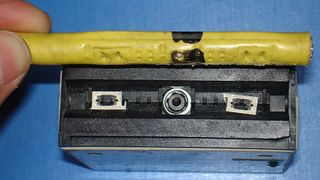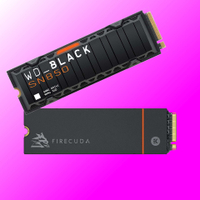The year is 1983 and I'm about to vampire tap my thick Ethernet
Yes, it's a real thing, and it's completely normal (for the '80s).

Thick Ethernet is not what I expected the progenitor of modern-day networking to be named, but alas, it is. This form of Ethernet, 10BASE5, also called thicknet, and IEEE 802.3 standard if you're boring, was the first commercially available standardised implementation back in 1983, and got its name for its uses of "thick and stiff" coaxial cable.
Slightly eccentric computing history that I, a child of the early '90s, had no clue about until just now.
Better yet, this thicknet used an immensely satisfying method of attaching devices to a network. Rather than plumb in your average RJ45 connector, with thicknet the easiest way to connect a new device to a network was by puncturing the outer cable shielding and probing into the electrically conductive cabling within. This was known as a vampire tap.
Vampire taps actually were created to save a lot of hassle with cutting a cable on both ends and wiring new connectors every time a new device was added.
I came across this iconic information while scrolling TikTok, as us sort of young(ish) but actually 30-year-old folk like to do, where a video from davidbombal showcases the actual vampire tapping process through actual physical examples. In the video, you can see the actual connector used to puncture the cable and keep a firm 'bite' onto it. It's a great video, and a look into the surprisingly brutal beginnings of Ethernet as we know it today.
Admittedly, it looks just a little more fiddly than plugging in an RJ45 connector on both ends.
How I've made it this far without running into potentially the two epicly-named things in computing history, I don't know. And doesn't this just make you think today's networking cables aren't anywhere near thick, or vampiric, enough.
The biggest gaming news, reviews and hardware deals
Keep up to date with the most important stories and the best deals, as picked by the PC Gamer team.
@davidbombal ♬ original sound - davidbombal
Thick Ethernet, or thicknet, was replaced later on in the '80s by thinnet. Thinnet, otherwise known as 10BASE2, cheapernet, or thin Ethernet if you're boring was the dominant standard for up to 10 Mbps connections (that's what the 10 stands for in 10BASE2) up until the early '90s. One reason for this was because its thinner cables were generally cheaper to buy and easier to fit.
After that came 10BASE-T, which used twisted pair cables instead of coaxial, and which is still used in the modern day. 10BASE-T became 100BASE-TX (the aptly named fast Ethernet—gotta love these matter-of-fact names). Then 1000BASE-T, and later 10GBASE-T. The latter increasing speeds all the way up to 10 Gbps, which pretty much brings us up into the modern-age.
Best SSD for gaming: The best solid state drives around
Best PCIe 4.0 SSD for gaming: Speedy drives
The best NVMe SSD: Slivers of SSD goodness
Best external hard drives: Expand your horizons
Best external SSDs: Fast, solid, and portable

Jacob earned his first byline writing for his own tech blog. From there, he graduated to professionally breaking things as hardware writer at PCGamesN, and would go on to run the team as hardware editor. He joined PC Gamer's top staff as senior hardware editor before becoming managing editor of the hardware team, and you'll now find him reporting on the latest developments in the technology and gaming industries and testing the newest PC components.
Most Popular







